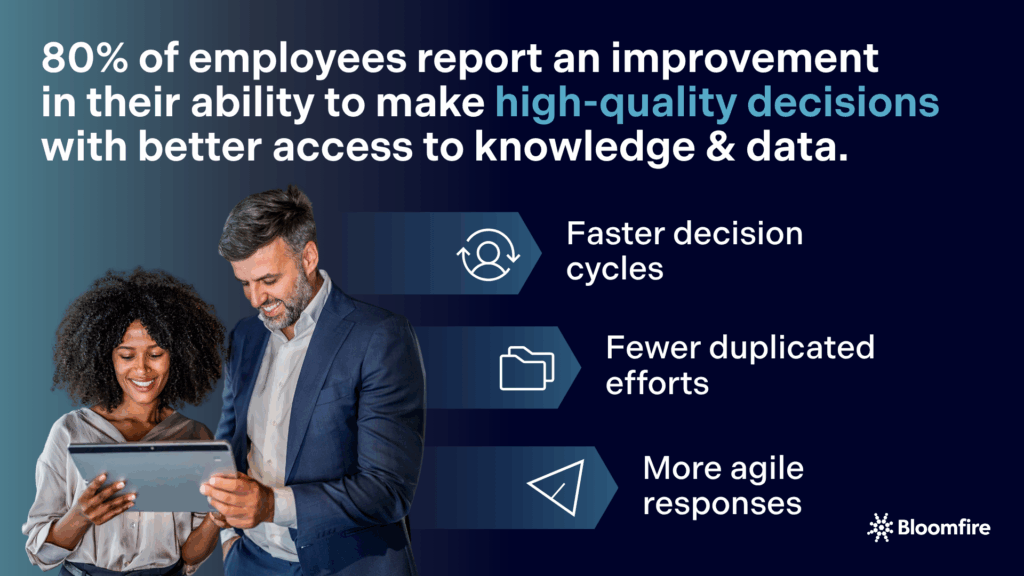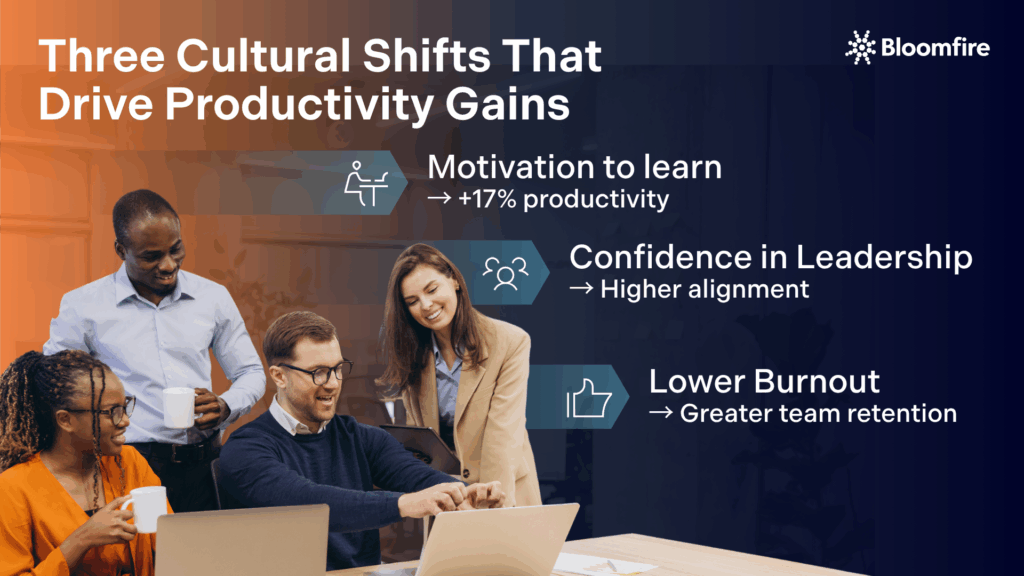Productivity Driven Revenue Growth: Unlocking Enterprise Value Through Knowledge Activation

Productivity has long been treated as an internal efficiency metric. But in today’s connected enterprise, it’s something far more strategic: a revenue lever.
When teams can access and apply knowledge in real time, they move faster, make better decisions, and contribute more directly to business outcomes. In fact, according to Bloomfire’s research, 98% of employees say they’re more productive when information is shared across departments.
This post examines how organizations can leverage productivity gains into measurable growth by harnessing real-time business intelligence, facilitating efficient decision-making, and surfacing actionable insights where work occurs.
Because true enterprise value isn’t just created by working harder. It’s built by removing friction, aligning people to purpose, and designing systems that help your teams deliver impact at speed.
The Lost Revenue Hidden in Everyday Friction
Business processes may work well for individual departments and teams, but it’s often at the handoffs between groups where the outputs from one team don’t match the needed inputs from another team, creating friction at the margins.
Every organization talks about “working smarter,” yet many still lose critical time—and revenue—to this avoidable friction.
Based on data from 10,000 users across 115 companies, Bloomfire’s Value of Enterprise Intelligence report reveals a costly truth: knowledge workers spend hours each week duplicating effort or searching for information buried in fragmented systems. It’s not just frustrating—it’s expensive. This delay ripples across project cycles, slows decision-making, and introduces costly rework. In moments where speed or clarity creates a competitive advantage, those delays translate into missed revenue opportunities.
But this isn’t just a workflow inefficiency. It’s a system design flaw.
When knowledge is locked in silos or hoarded in email threads, teams can’t operate with the agility modern markets demand. By contrast, systems that enable real-time knowledge sharing empower employees to act faster, align quicker, and avoid reinventing the wheel.
This is where Enterprise Intelligence shifts the equation. It’s not just about storing knowledge—it’s about making it immediately accessible and actionable across the business. That shift—from friction to flow—is what turns productivity into performance.
The Value of Company-Wide KM
See how cross-team knowledge sharing boosts productivity and business impact.
Learn More
Measuring the Value of Productivity Gains
Too often, productivity is framed in operational terms—tasks completed, hours logged, or tickets closed. But organizations serious about growth are starting to measure productivity by a more meaningful metric: revenue per employee.
Our report outlines a methodology for doing just that—quantifying how productivity gains translate into business outcomes. The approach is simple: calculate the impact of improvements in knowledge sharing and decision-making on revenue, and then apply those gains across roles and departments.
The results are significant.
Key Drivers of Productivity-Linked Revenue Gains
One regional financial institution attributed $130 million—or 37% of its annual revenue—to productivity gains powered by knowledge management. Another service-based company calculated a $77.4 million impact, equivalent to 22% of its annual earnings. These outcomes stemmed from improvements in:
- Employee engagement: Empowered teams contribute more consistently and retain institutional knowledge
- Decision quality: Better insights lead to smarter, faster actions
- OKR attainment: Clearer alignment between strategy and execution
- Motivation to learn: Continuous skill-building improves output and adaptability
Importantly, this value didn’t come solely from sales. Support functions, including HR, IT, and Finance, played a crucial role in enabling productivity across the business.
This isn’t about cost containment—it’s revenue acceleration through smarter systems and shared intelligence.
The Role of Real-Time Business Intelligence in Productivity Activation
Most leaders associate business intelligence with dashboards—snapshots of performance data updated periodically. But in the era of Enterprise Intelligence, business intelligence becomes something more dynamic: real-time, contextual knowledge delivered directly into decision points.
This shift from static reporting to real-time business intelligence has massive implications for productivity. When employees can access relevant insights as they work—rather than pausing to search across disconnected systems—they move faster, duplicate less, and respond more effectively to changing priorities.
Our research also found that 80% of employees report an improvement in their ability to make high-quality decisions, thanks to better access to knowledge and data. That translates into:
- Faster decision cycles, reducing lag between analysis and action
- Fewer duplicated efforts, as teams avoid reinventing solutions that already exist
- More agile responses to customer needs, competitive shifts, and operational risks

Behind this capability is more than just smarter search. It’s the combination of AI-powered surfacing, insight reuse, and self-organizing knowledge systems that adapt to the evolving needs of the business.
Real-time business intelligence isn’t a reporting upgrade; it’s a productivity engine. And it’s one of the key reasons why companies that adopt Enterprise Intelligence outperform their peers in both decision velocity and revenue per employee.
From Decision Speed to Revenue Growth: The Case for Efficient Decision Making
Efficient decision-making isn’t just about being fast—it’s about making the right call, with confidence, and without delay. In high-performing organizations, it’s the compound result of three essential conditions:
- Access to trusted information at the moment of need
- Confidence in judgment, grounded in shared understanding
- Elimination of lag between insight and action
When these conditions are met, teams don’t hesitate—they align, act, and deliver. That velocity has a ripple effect: decisions become projects, projects move faster, and outcomes—whether revenue, retention, or innovation—materialize sooner.
According to the Value of Enterprise Intelligence report, teams that improved knowledge management saw that 47% exceeded OKR targets. That’s not just internal alignment—it’s evidence of clearer focus, faster execution, and better strategic outcomes.
But the upside isn’t just operational. It’s cultural.
When knowledge is easily accessible and openly shared, trust is built. Employees no longer second-guess decisions or hoard information to retain influence. Instead, they contribute, adapt, and stay aligned. That shift—from siloed judgment to shared intelligence—creates an environment where governance isn’t enforced from the top down, but emerges from a foundation of informed, confident action.
And that’s where efficient decision-making transforms from process optimization into a strategic growth lever.
Building a Culture of Shared Intelligence
Real-time knowledge sharing isn’t just a systems upgrade—it’s a cultural shift. While platforms and AI can surface insights, it’s the organizational norms around transparency, learning, and trust that determine whether knowledge actually flows.
Nearly 46% of employees believe that better cross-departmental knowledge sharing would significantly increase their productivity, according to the Value of Enterprise Intelligence Report. However, the impact extends beyond individual efficiency.
When employees are encouraged—and expected—to share what they know, culture begins to evolve in three key ways:
- Increased motivation to learn: Employees are 47.9% more likely to pursue self-learning when knowledge is easily accessible—leading to a 17% boost in productivity.
- Greater confidence in leadership: When the rationale is transparent and the data is shared, trust in decision-makers grows across teams.
- Lower burnout and attrition: Employees who feel equipped and valued are less likely to disengage, which reduces turnover and boosts performance continuity.

This isn’t culture as window dressing. It’s culture as infrastructure.
Organizations that treat knowledge as a shared asset—rather than a personal advantage—build more resilient, aligned, and high-performing teams. Shared intelligence becomes a competitive advantage, not just a feel-good initiative.
In this way, culture isn’t soft. It’s strategy, reinforced by the systems and habits that govern how people access, use, and expand their knowledge.
Rethinking Productivity as a Growth Strategy
It’s time to move beyond measuring productivity by output alone. In today’s knowledge-driven organizations, productivity is no longer just about efficiency—it’s a growth accelerator.
The real question isn’t “How much work is getting done?” It’s “How quickly does that work translate to outcomes?” When knowledge flows freely, decisions happen faster, execution improves, and measurable impact follows.
This is especially true in functions that depend on alignment and speed—like customer experience, operations, and product innovation—where the ability to accelerate product development hinges on real-time insights and efficient decision-making.
That’s the promise of Enterprise Intelligence: systems designed to activate knowledge, align people to outcomes, and maximize revenue per employee.
Leaders looking to remove friction and unlock enterprise value should rethink productivity not as an internal metric, but as a lever for growth.
Unlock Enterprise Intelligence
Learn how Bloomfire helps teams turn knowledge into revenue-driving outcomes.
Explore Our Solutions
How to Improve Customer Service in Call Centers: 21 Ways to Enhance Contact Center Experience

Innovative Ways Companies Are Using Knowledge Management

How to Implement a Knowledge Check in 6 Steps

Estimate the Value of Your Knowledge Assets
Use this calculator to see how enterprise intelligence can impact your bottom line. Choose areas of focus, and see tailored calculations that will give you a tangible ROI.

Take a self guided Tour
See Bloomfire in action across several potential configurations. Imagine the potential of your team when they stop searching and start finding critical knowledge.
